End-Semester Examination - 28.04.04
total marks - 85, time - 3 hours
Instructions : One page of hand-written notes is allowed.
Physical & Astrophysical Data :
Multiple Choice : 1 x 10 = 10
- A photon leaving a region of strong gravity
- will be unaffected.
- will lose energy and thus slow down.
- will lose energy and thus be red-shifted.
- will gain energy and thus be blue-shifted.
- An important difference between the evolution of a one solar mass star
and a more massive star is that the more massive star
- has a degenerate core throughout its lifetime.
- does not become degenerate and therefore does not have a helium flash.
- skips hydrogen burning and begins with helium burning instead.
- lives for a longer time.
- The source of the energy that is radiated from the photosphere of a protostar is
- gravitational contraction.
- deuterium burning.
- hydrogen burning.
- none of the above.
- Type-II Supernova are probably caused by
- the decay of radioactive elements.
- two binary stars colliding with each other.
- the collapse of the iron core of a massive star.
- the formation of a massive star.
- When the temperature of the gases in the universe fell sufficiently for protons and electrons
to recombine to form neutral hydrogen, which cosmologically significant event occurred?
- The temperature was about
 , as we observe today.
, as we observe today.
- The photons in the universe uncoupled from the matter.
- The gravitational force froze out of the GUT.
- The galaxies were created.
- Which of the following is not true of the cosmic microwave background radiation?
- It is nearly equally bright in all directions.
- Its total energy content has always been smaller than the energy in the matter.
- It was produced about a million years after the beginning of the expansion.
- It is brightest in the radio part of the spectrum.
 radiation can not
radiation can not
- pass freely through the disk of the Galaxy.
- be observed by the Kavalur telescope.
- be produced when a hydrogen atom's electron changes its spin.
- be used to detect the neutral hydrogen regions.
- When hydrogen is fusing in a thin shell around the core
- the core will expand
- the envelope will expand
- the core will collapse
- the star will explode as a supernova
- A hypothetical cluster of stars is observed to have no main sequence stars more massive
than 0.5
 . The approximate age of this cluster would be
. The approximate age of this cluster would be
- one million years.
- hundred million years.
- one billion years.
- ten billion years.
- The radiative emission from the pulsars is mainly due to
- thermal bremsstrahlung.
- synchrotron radiation.
- atomic transitions.
- thermal X-ray emission.
Identification : 20
- Study the model Hertzsprung-Russel diagram in fig.[1] and write the
number of the star which best corresponds to the descriptions below - [2 x 5 = 10]
- is the least massive.
- is fusing helium in its core.
- is supported by electron degeneracy.
- has the smallest main-sequence life-time.
- has the largest radius.
Figure 1:
A model H-R diagram.
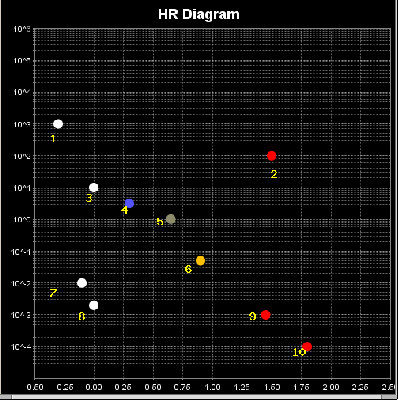 |
- A series of atomic nuclei are shown in fig.[2]. Which nuclear reaction
do these correspond to? Write down the relevant reactions. [5]
Figure 2:
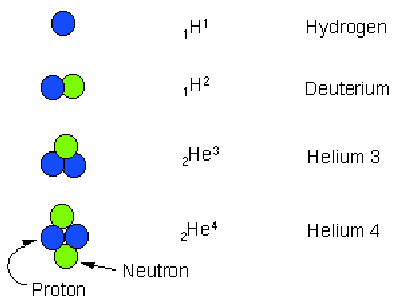 |
- Briefly discuss the physics described in fig.[3]. [5]
Figure 3:
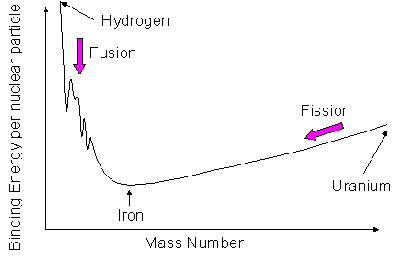 |
Short Questions : 3 x 10 = 30
- Hot emission nebulae are usually found near star-forming regions. Why?
- Stellar evolution time-scales are very large compared to human life-times. How can
our theories of stellar evolution be tested against observation?
- There is evidence for significant amount of mass in our Galaxy which has not been
seen in any wavelength. Given what you know of stellar evolution, list three possible
candidates for some of this dark matter and justify your choices.
- Estimate the minimum rotation period of a neutron star and compare it with observed pulsar
periods.
- How should the shape of a pulsar signal change because of the dispersion in the inter-stellar
medium.
- Everyone of us have been inside a supernova. Explain the statement.
- Show that at long wavelengths Planck's radiation law is approximately proportional to the
fourth power of the wavelength.
- Very briefly outline the evolution of a 1
 star.
star.
- Discuss the difference in the energy transport (from the centre to the surface) for a
lighter and a heavier star.
- Find the Kelvin-Helmholtz time-scale for the Sun.
Long Questions : 5 x 5 = 25
- The Earth-Moon Lagrange points
 and
and  are located such that the angle formed by
the positions of the Moon, the Earth and either Lagrange point, with the Earth at the
apex, is equal to
are located such that the angle formed by
the positions of the Moon, the Earth and either Lagrange point, with the Earth at the
apex, is equal to  (fig.[4]). Calculate the effective potential at
(fig.[4]). Calculate the effective potential at  .
.
Figure:
Lagrange points of the Earth-Moon system.
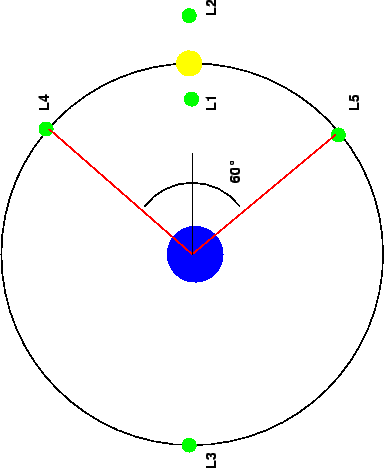 |
- The brightness and temperature of two stellar clusters with known distances were measured
and plotted on the Hertzsprung-Russell diagrams as shown in fig.[5].
- Which is the younger cluster?
- Which cluster is more likely to have a Type-II supernova?
- List one assumption that you have made to answer part (a).
Figure:
H-R diagram for clusters A and B.
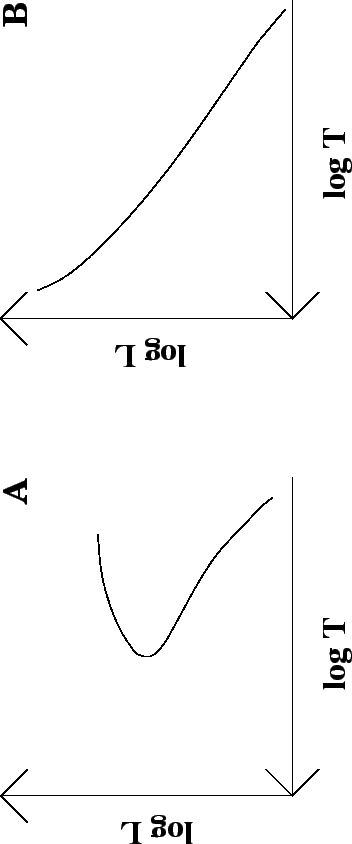 |
- Derive an approximate mass-radius relation for a white dwarf supported by the degeneracy
pressure of - a) non-relativistic electrons, b) relativistic electrons.
- Write down the induction equation. Estimate the ohmic decay time-scale of the magnetic
field in a neutron star with
 and
and
 .
.
- Imagine that we live in a different universe, where Newton's law of gravity is given by
 , rather than the
, rather than the  law that we know and love. (a) Would linear
momentum be conserved under this interaction? (b) Would angular momentum be conserved under
this law?
law that we know and love. (a) Would linear
momentum be conserved under this interaction? (b) Would angular momentum be conserved under
this law?
Sushan Konar
2004-05-05